Camping is all about exploring the great outdoors and creating unforgettable memories. And what better way to enhance your camping experience than by cooking your meals and training yourself on how to cook while camping
In this comprehensive guide, we’ll show you how to cook while camping, from choosing the right equipment to preparing delicious campfire recipes, making your outdoor culinary adventures a culinary delight.
Why Cook While Camping?
Cook While Camping offers numerous advantages:
- Cost-Effective: Preparing your meals can save you money compared to dining out.
- Healthy Options: You have control over the ingredients, allowing you to cook nutritious and delicious meals.
- Customization: You can tailor your meals to your preferences, accommodating dietary restrictions and food allergies.
- Enhanced Experience: Cooking outdoors adds a unique dimension to your camping trip, creating memorable moments around the campfire.
Essential Camping Cooking Equipment
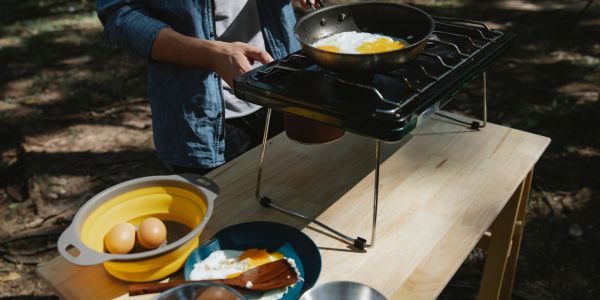
Before you embark on your culinary adventure in the great outdoors, make sure you have the essential cooking equipment for Cook While Camping:
COOKWARE

- Cast Iron Skillet: A cast iron skillet is a versatile choice for open-fire cooking. It retains heat well and can be used for frying, sautéing, or baking delicious dishes.
- Grill Grate: A grill grate or grilling grid is perfect for cooking foods like burgers, steaks, or vegetables directly over the flames. It allows for those classic grill marks and smoky flavors.
- Dutch Oven: A Dutch oven is excellent for making stews, soups, or even baking bread over an open fire. Its heavy construction ensures even heat distribution.
- Campfire Pot or Kettle: For boiling water, making coffee, or cooking larger meals, a campfire pot or kettle with a sturdy handle is essential. It can be suspended over the fire or placed on a grate
COOKING SURFACES

- Stovetop Range: A stovetop range is a common cooking surface in kitchens. It usually consists of electric or gas burners with temperature control, making it suitable for various cooking techniques.
- Oven: An oven provides a consistent and dry cooking environment, ideal for baking, roasting, and broiling. It’s perfect for dishes like casseroles, bread, and roasted meats.
- Grill: Grills, whether charcoal, gas, or electric, are fantastic for outdoor cooking. They impart a smoky flavor and beautiful grill marks on foods like burgers, steaks, and vegetables.
- Campfire or Open Fire: If you’re camping or cooking outdoors, a campfire or open fire can serve as a versatile cooking surface. You can use grates, skewers, or pots and pans to prepare a variety of dishes over an open flame.
POTS AND PANS
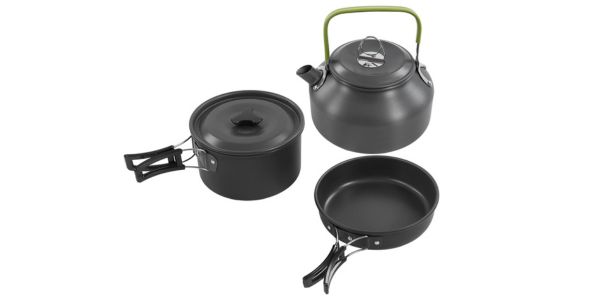
Pots and pans are essential tools in the kitchen, each designed for specific cooking tasks. Here are four types of pots and pans:
- Saucepan: A saucepan has high, straight sides and a long handle. It’s ideal for heating or simmering liquids, making sauces, and cooking grains or pasta.
- Frying Pan (Skillet): Frying pans have shallow, sloping sides and are perfect for sautéing, frying, and making omelets. They come in various sizes, from small for single servings to large for family meals.
- Dutch Oven: A Dutch oven is a heavy, lidded pot, typically made of cast iron or other durable materials. It’s great for slow-cooking stews, braising meats, and even baking bread.
- Stockpot: Stockpots are large, deep pots with a lid and sturdy handles. They’re excellent for preparing large quantities of soup, stock, pasta, or boiling corn on the cob
UTENSILS
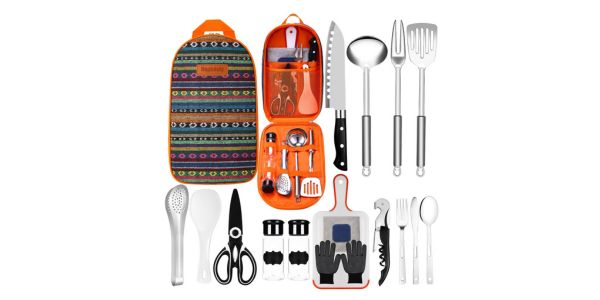
Utensils are kitchen tools that make cooking and food preparation easier. Here are four essential utensils:
- Chef’s Knife: A versatile, sharp knife that’s a kitchen workhorse, suitable for slicing, dicing, chopping, and more.
- Spatula: A flat, flexible tool used for flipping and turning foods like pancakes, burgers, or omelets in a pan.
- Tongs: Tongs are used for grasping and turning food items on the grill or in a pan. They come in various lengths and materials to suit different cooking tasks.
- Whisk: Whisks are used for beating, mixing, and incorporating air into ingredients, making them essential for tasks like whipping cream or mixing batter.
ACCESSORIES
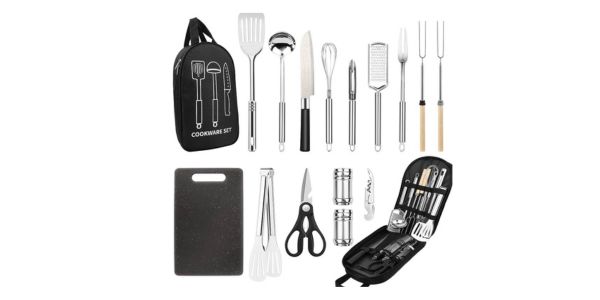
Kitchen accessories are handy tools that complement your cooking and meal preparation. Here are four useful kitchen accessories:
- Measuring Cups and Spoons: Measuring cups and spoons are essential for accurately portioning ingredients, ensuring your recipes turn out as intended.
- Cutting Board: A good cutting board provides a safe and clean surface for chopping, slicing, and preparing ingredients.
- Mixing Bowls: Mixing bowls in various sizes are useful for combining ingredients, marinating, and serving. They come in materials like glass, stainless steel, or plastic.
- Kitchen Timer: A kitchen timer helps you keep track of cooking times, preventing overcooking and ensuring your dishes are perfectly cooked.
Choosing the Right Spot for Your Campfire Cooking Adventure
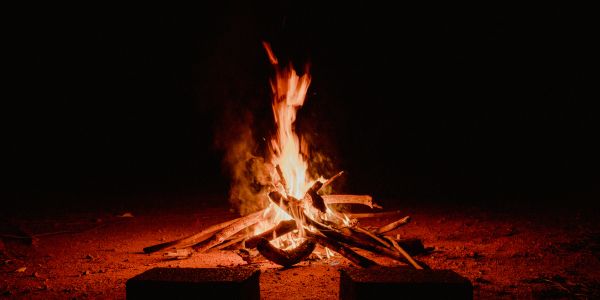
Selecting the perfect spot for your campfire cooking adventure is the first step to ensure a safe and enjoyable experience in the great outdoors. Here’s why it’s crucial and how to do it right.
Safety First:
- When it comes to campfire cooking, safety should always be your top priority.
- Start by finding a designated campfire area in your camping site
- choose a spot at least 200 feet away from overhanging branches, dry grass, and any flammable materials. This minimizes the risk of uncontrolled fires and accidents.
Flat Ground:
- Look for a flat and level ground to set up your campfire.
- This ensures your cooking equipment won’t tip over, and your food will cook evenly. Uneven ground can lead to hot spots or accidents.
Clear Area:
- Before starting your fire, clear the area of any debris or flammable materials.
- Remove leaves, twigs, and sticks from the fire pit or cooking area to prevent sparks from spreading.
Wind Direction:
- Pay attention to the wind direction. You don’t want the wind blowing smoke and sparks toward your campsite or cooking area. Position yourself so that the wind carries the smoke away from you.
CAN YOU COOK ON A FIRE PIT?
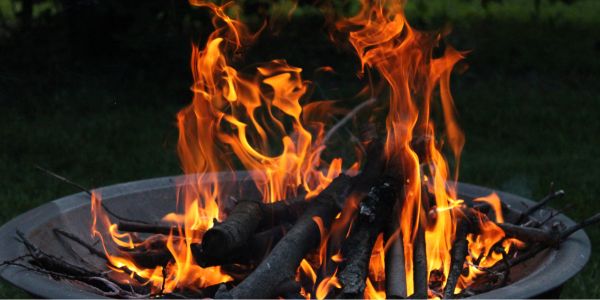
Absolutely Yes! You can definitely cook on a fire pit. It’s a fantastic way to enjoy outdoor cooking and get that smoky, delicious flavor in your food.
Just set up your fire pit, let the wood burn down to create hot coals, and then you can use a grill grate or a cast-iron skillet to cook all sorts of goodies like burgers, hot dogs, marshmallows for s’mores, or even some veggies in foil packets.
It’s a great way to bond with friends and family around a warm, crackling fire while making some tasty meals. Just remember to be safe, and keep an eye on the fire while you’re cooking!
HOW TO BUILD THE PERFECT COOKING CAMPING FIRE
To build the perfect cooking camping fire, consider these three critical factors:
Wood Selection:
- Choose dry, seasoned firewood for easy ignition and a steady burn.
- Ensure you have a mix of tinder, kindling, and fuelwood in various sizes.
Location:
- Pick a safe, open area with no overhanging branches or flammable materials.
- Use a designated fire pit if available, or create a ring of rocks to contain the fire.
Wind and Water:
- Be mindful of wind direction when lighting the fire to prevent flames from spreading.
- Have a water source, like a bucket, nearby for safety and to fully extinguish the fire when you’re done.
Tips For Perfect Cook While Camping
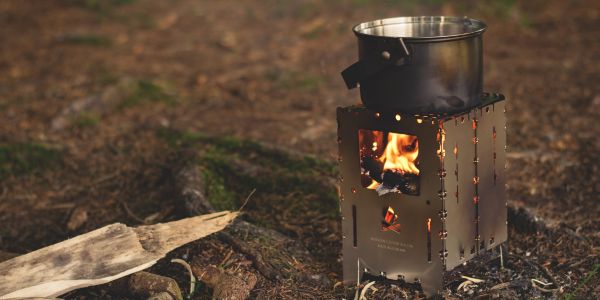
Campfire cooking or Cook While Camping can be a rewarding experience, but it requires some skills and preparation. Here are some tips to get you started:
1. Plan Your Camping Menu
The foundation of a successful camping cooking experience begins with planning your menu. Before you hit the trail, decide what meals you’ll be preparing during your camping trip. Create a detailed shopping list to ensure you have all the ingredients you need. When creating your menu, consider factors like the number of campers, dietary restrictions, and the availability of cooking equipment.
2. Choose the Right Cooking Equipment
Selecting the appropriate cooking equipment is crucial when camping. Depending on your camping style, you might use a campfire, portable camping stove, or a combination of both. If you’re going the campfire route, ensure you have a sturdy grill, cooking utensils, and cookware suitable for open flames.
3. Build a Campfire:
- Choose a safe and designated campfire area if available, or create a fire pit following Leave No Trace principles.
- Use dry wood and kindling to start your fire. You can also use charcoal if that’s your preferred fuel source.
4. Cooking Tips:
- Adjust the heat by moving cookware closer or further from the fire.
- Use foil or cooking spray to prevent food from sticking to the grill or pot.
- Be patient and cook slowly; the flavor from a campfire-cooked meal is worth the wait.
5. Embrace the Foil Packet Method
Foil packet cooking is a camper’s best friend. This method involves wrapping your ingredients in aluminum foil and placing them on hot coals or a grill. It’s a simple way to prepare a wide variety of dishes, from foil packet breakfasts to foil packet dinners.
6. Stock Up on Pre-Packaged Meals
For a hassle-free camping experience, consider pre-packaged meals. Companies offer a wide range of dehydrated or freeze-dried meals that only require boiling water. These meals are not only convenient but also lightweight and have a long shelf life.
7. Prepare Easy Camping Recipes
While camping, simplicity is often key. Opt for easy-to-prepare recipes that require minimal ingredients and preparation. Some crowd-pleasers include one-pot pasta dishes, grilled skewers, and campfire roasted marshmallows for a classic dessert.
8. Stay Organized
Organization is vital for stress-free camping cooking. Label your ingredients and meal packets, keep your cooking area clean, and have a designated food storage system to prevent attracting wildlife.
9. Be Mindful of Safety
Camping safety is paramount. Make sure to follow all fire safety rules, and always clean up after yourself to minimize the impact on the environment. Additionally, educate yourself on food safety and proper food storage to avoid foodborne illnesses.
10. Experiment and Have Fun
Camping is all about enjoying the great outdoors, so don’t be afraid to get creative with your campfire cooking.
Try out new recipes, experiment with different flavors, and savor the moments around the campfire with friends and family.
Take Care of these 3 Essential Parts of Cook While Camping
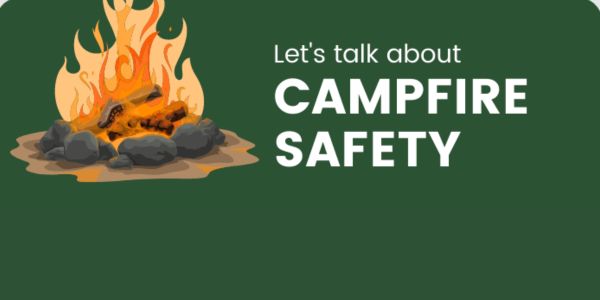
Cook While Camping, it’s essential to pay special attention to three crucial aspects to ensure that your meals are safe, delicious, and enjoyable. These three essential parts of camp cooking are:
Food Safety:
- Proper food handling and storage are vital to prevent foodborne illnesses while camping. Follow these guidelines:
- Use a well-insulated cooler with ice packs to keep perishable foods at a safe temperature (below 40°F or 4°C).
- Keep raw meat, poultry, and seafood separate from ready-to-eat foods to prevent cross-contamination.
- Pack food in airtight containers or ziplock bags to prevent pests and wildlife from accessing your supplies.
- Cook meats and poultry to the recommended internal temperatures to ensure they are safe to eat.
Cooking Equipment and Fire Safety:
- Your cooking equipment and the way you handle fire are critical for camp cooking:
- Check your camp stove, portable grill, or campfire setup to ensure it’s in good working condition.
- Use a stable and level cooking surface to prevent accidents.
- Always have a fire extinguisher, bucket of water, or hose nearby when using an open flame for cooking.
- Follow local regulations and fire restrictions, and never leave a fire unattended.
Leave No Trace:
- While cooking in the great outdoors, it’s essential to minimize your impact on the environment. Follow Leave No Trace principles:
- Cook at least 200 feet (70 adult steps) away from lakes, streams, and trails to protect water sources.
- Dispose of wastewater properly, away from water sources, by using a sump hole or a designated disposal area if available.
- Pack out all food scraps and trash, leaving your campsite cleaner than you found it.
- Avoid using soap or detergents directly in natural water sources, as they can harm aquatic life.
Conclusion
Cook While Camping is a delightful way to enhance your outdoor experience. With the right equipment, preparation, and recipes, you can enjoy delicious meals under the open sky. Whether you’re a seasoned outdoor chef or a beginner, the joy of Cook While Camping is a rewarding experience that connects you with nature and creates lasting memories. So, gear up, pack your ingredients, and savor the taste of adventure on your next camping trip!
FAQs
Here are some frequently asked questions (FAQs) for cook while camping:
What equipment do I need for Cook While Camping?
You’ll need basic camping cookware, such as a portable stove or campfire equipment, pots and pans, utensils, and plates. Additionally, consider a cooler for perishables and a camping grill if you plan on grilling.
What should I pack in my camping kitchen?
Essentials include food, cooking utensils, a can opener, spices, dish soap, a sponge, paper towels, and a lighter or matches for starting a fire. Don’t forget storage containers and trash bags for food storage and waste disposal.
How do I choose the right campsite for cooking?
Look for a campsite with a designated fire pit or grill, if you plan on using an open flame. Ensure you have access to a water source, and consider wind protection to make cooking easier.
What are some easy camping meal ideas?
Some simple options include foil packet meals, hot dogs, burgers, sandwiches, and instant oatmeal for breakfast. Canned soups and stews are also convenient.
How do I store food while camping?
Use a cooler with ice packs for perishables. Non-perishable items can be stored in airtight containers or resealable bags. Hang food from a tree or use bear-resistant containers if you’re in bear country.

